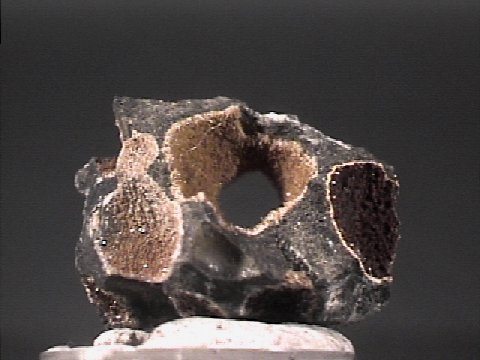 THE
MINERAL ERIONITE
THE
MINERAL ERIONITE
- Chemistry: approximately (K2, Na2, Ca)MgAl8Si28O72 - 28H2O, Hydrated Potassium Sodium Calcium Magnesium Aluminum Silicate
- Class: Silicates
- Subclass: Tectosilicates
- Group: Zeolites
- Uses: Mineral specimen and chemical filter.
Specimens
Erionite is one of the rarer zeolites, a popular group of minerals to
collect. Erionite has been challenged as a new mineral species. It was
thought to be another rare zeolite named
Erionite forms wool-like, fibrous masses in the hollows of rhyolitic tuffs and in basalts. The form is such that hardness measurements are impossible and basically irrelevant. The crystals not only look like wool they feel like wool as well. But they are brittle and stroking a specimen of erionite is a good way to ruin a specimen erionite, (see okenite). Erionite was first described by A.S. Eakle in 1898, as white woolly fibrous masses in cavities in rhyolite lava from near Durkee, Baker County, Oregon.
Erionite's structure has a typical zeolite openness that allows large ions and molecules to reside and actually move around inside the overall framework. The structure actually contains open channels that allow water and large ions to travel into and out of the crystal structure. The size of these channels controls the size of the molecules or ions and therefore a zeolite like erionite can act as a chemical sieve, allowing some ions to pass through while blocking others.
Evidence suggests that erionite may be more toxic than serpentine asbestos. According to Dr. Bill Cordua, U. Wisconsin - River Falls:
This mineral is considered so hazardous that the EPA requires any one who intends to manufacture, import or process any article containing erionite to notify the E.P.A. 90 days in advance. ... It is not clear why erionite is so toxic. Other fibrous zeolites tested - mordenite and various synthetic zeolites - have so far not shown erionite's toxicity. Whether the cause is erionite's shape, some aspect of its surface reactivity, its resistant to dissolution in fluids in the lung, or some combination of these, is not known.For more information, see "Deadly Erionite". Needless to say, we would recommend that any erionite specimens be secured in a sealed container, and exposure to erionite dust should be avoided.
PHYSICAL CHARACTERISTICS:
- Color is colorless or white.
- Luster is vitreous.
- Transparency: Crystals are transparent to translucent.
- Crystal System is hexagonal.
- Crystal Habits is limited to wool-like aggregates and crusts.
- Hardness is unknown.
- Specific Gravity is approximately 2.0 (very light)
- Streak is white.
- Associated Minerals are opal,
calcite,
heulandite,
clinoptilolite,
pyrite,
thenardite,
halite,
celandonite ,herschelite , phillipsite, chabazite, analcime and other zeolites. - Notable Occurrences include Durkee, Baker County, Oregon; Nevada, South Dakota and Arizona, USA and the Faroe Islands.
- Best Field Indicators are crystal habit, low density, locality and associations.


